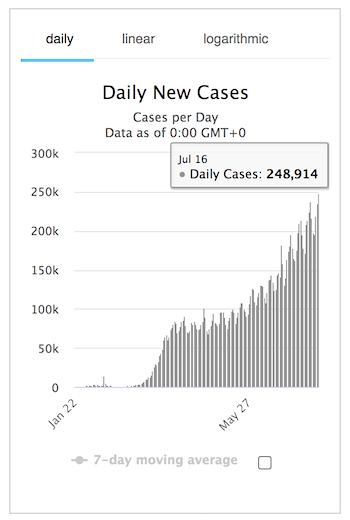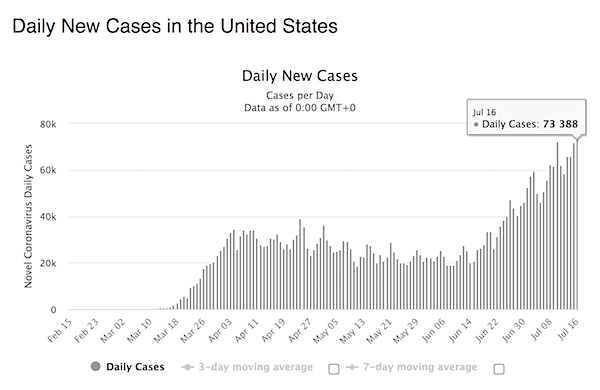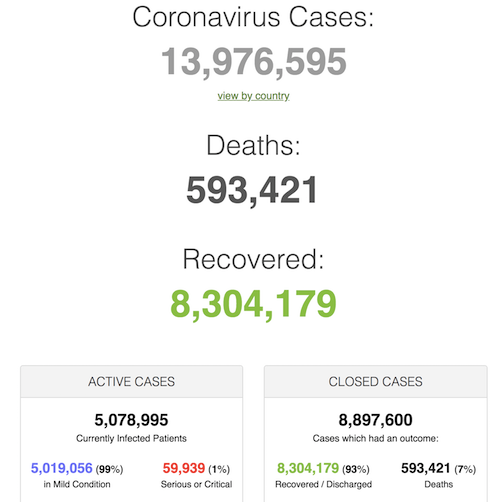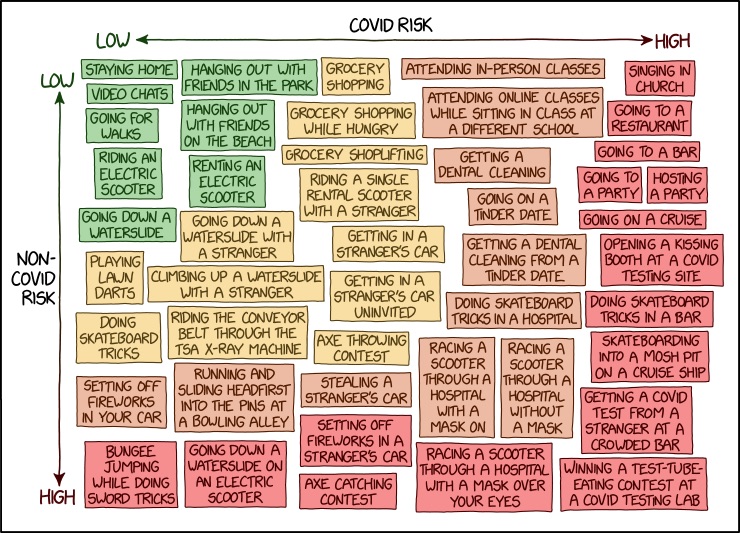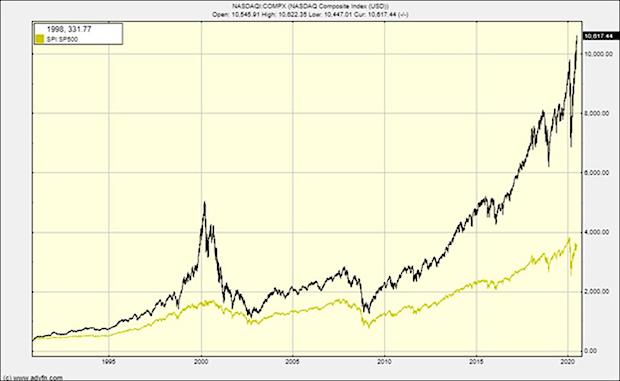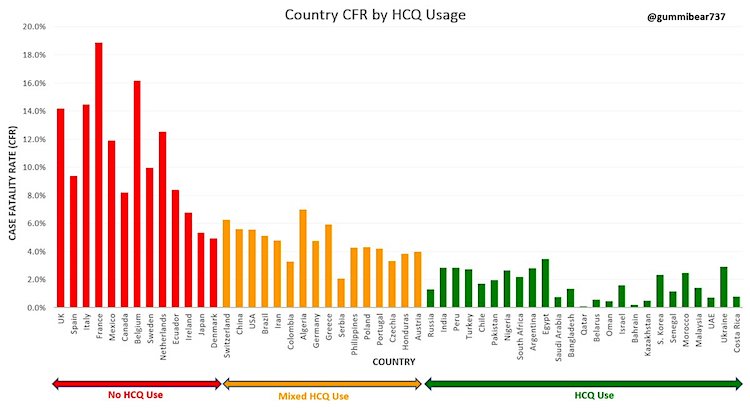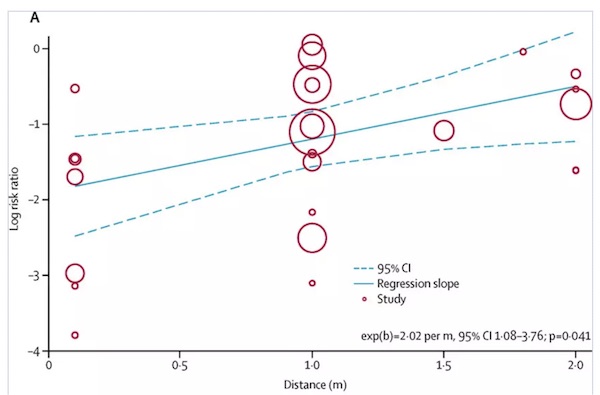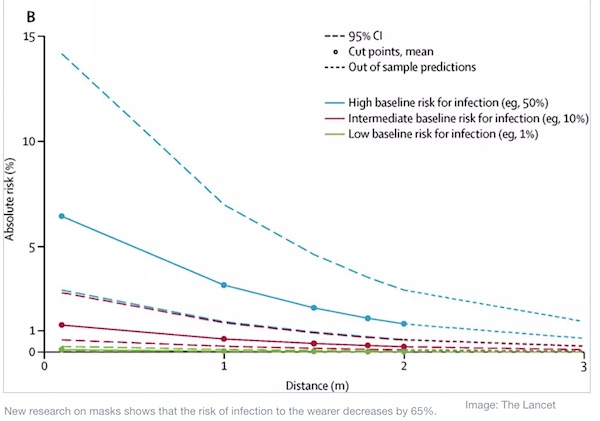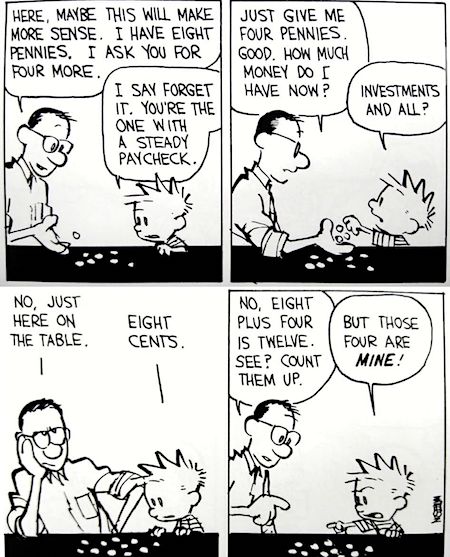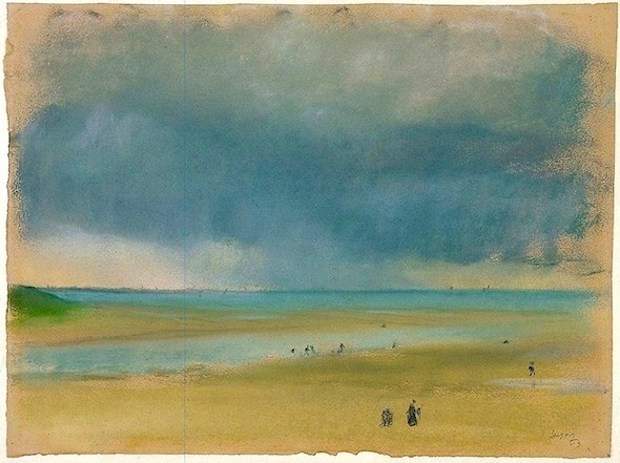
EdgarDegas A la mer 1863

I guess it was perhaps inevitable, but today I find myself wondering what news to aggregate here. This is because Donald Trump has managed to now completely monopolize the media, and neatly divide it into two diametrically opposed camps. On the one hand there’s the camp that says the President is doing very well, on the other hand there are those who claim his condition is much graver that let on, and everybody’s lying who says it’s not.
It’s probably wise to realize that the media today is entirely based on a clickbait chase, and therefore on scandalizing and manipulating everything. The aim is not to inform people, but to make them click and read, click and read, rinse and repeat. Brought to you by their sponsors.
Personally, I think it would take a Herculean effort to get so many doctors and others in on the Big Lie, but on the other hand it’s entirely logical if the reports on his condition are skewed towards the positive. One would think that in normal times the press and the people could wait a few days to see how the disease evolves, but that doesn’t produce clickbait, which translates into no revenue. So that’s out.
I like this quote someone tweeted: “Burroughs once explained the phrase “Naked Lunch” as referring to “a frozen moment when everyone sees what is on the end of every fork.” A better line than any in the book itself, I should say, and the perfect description of America this morning.”
But I thought I wouldn’t join that big effort here today, even if that leaves precious little other news. Still, here’s Trump speaking:
Trump

German lawyer COVID scandal
https://twitter.com/i/status/1312639876970491904

Maté
https://t.co/BI8onJMTPU pic.twitter.com/VJeJzZgssU
— Aaron Maté (@aaronjmate) October 4, 2020

Everyone’s an export on COVID, but nobody knows a thing.
• Scientists Study Whether Immune Response Wards Off Or Worsens COVID (O.)
British scientists have launched a major study aimed at uncovering the critical role that human antibodies and other immune defences play in the severity of Covid-19 cases. Results could support some scientists’ belief that antibodies triggered by common colds could be protecting children against the disease. Alternatively, the study could confirm other researchers’ fears that some immune responses to the virus may trigger deadly inflammatory reactions that could bedevil attempts to create anti-Covid vaccines. “This study could go in two very different directions,” said Michael Levin, professor of paediatrics at Imperial College London. “It could reveal that cross-reacting antibodies explain why children are less likely to suffer from severe Covid-19, or it might show patients’ own immune responses cause life-threatening effects.”
The study is being carried out by Levin’s group, a team led by Professor George Kassiotis at London’s Francis Crick Institute, and scientists led by Dan Davis, University College London. They will use thousands of samples which have been collected as part of existing studies funded by the EU and Wellcome. Much of the groups’ work will focus on antibodies, key immune defence proteins that bind on to viruses to block their activity. When Covid-19 first appeared, scientists began searching for antibodies against the virus in patients and healthy individuals and to their surprise found them not just in samples taken from recently infected people but in specimens that had been collected before the pandemic began.
“We discovered a small group – about 6% of the UK population – already had antibodies that could recognise the new virus, although they’ve never been exposed to it,” said Kassiotis. “We realised there must be cross reactivity occurring between common cold coronaviruses and the new pandemic strain. Both are coronaviruses, after all.” Coronaviruses cause about a fifth of UK common colds and antibodies triggered by them latch on to the Covid-19 virus. But could they actually be blocking Covid activity? “Our laboratory experiments suggest this may be the case,” Kassiotis said. “These antibodies may actually protect against Covid-19.”
Adults get common colds caused by coronaviruses once every two or three years. In contrast children get them five or six times a year because they constantly reinfect each other at school, said Kassiotis. As a result about 60% of them have coronavirus antibodies, 10 times the adult level. “Children do not generally get severe Covid-19 and I believe that protection is provided by cross-reacting antibodies triggered by repeating coronavirus colds,” said Kassiotis.

“It typically takes about four days for Covid-19 symptoms to present, so early next week sometime the world will know if the bug made the president sick or if he shook it off like just another impeachment effort.”
• Low-Flying Black Swans (Jim Kunstler)
The New York Times almost wet its panties breaking the pre-dawn news that the president has tested positive for coronavirus. By the end of day, Democrats across the land — or, at least, up and down the east and west coasts — will be gathering unto Santeria shrines, lighting MAGA hats on fire, sacrificing chickens, drawing Wiccan pentangles in the moonlight, and entreating all the other unseen powers of Providence to rapture Mr. Trump into everlasting oblivion somewhere beyond the crab nebula. The Judeo-Christian God of our fathers must have a special animus for the Golden Golem of Greatness. He / She / It / or They have heaped more tribulation on Mr. Trump than on the biblical Job of Uz, anguishing in Yahweh’s holy whirlwind.
RussiaGate, VeryFinePeopleGate, UkraineGate, BoltonGate, now this! It typically takes about four days for Covid-19 symptoms to present, so early next week sometime the world will know if the bug made the president sick or if he shook it off like just another impeachment effort. The ordeal will also be an interesting test of the hydroxychloroquine + zinc regimen Mr. Trump says he’s been on. The joyful hysteria in the mainstream news is so boisterous this morning that The Times hasn’t even played its obvious next card, which, I guarantee you, will be an effort to postpone the hearings over SCOTUS nominee Amy Coney Barrett on account of coronavirus being on-the-loose among government officials.
I’m pretty sure that Senate Majority Leader Mitch McConnell will keep a firm hand on the tiller of that ship — even if the darn proceeding has to go full Zoom meeting, they will git’er done (as we say in Deplorable Land). If the virus doesn’t knock Mr. Trump on his ass, I imagine we’ll be seeing quite a lot of him campaigning by video in quarantine, old game-show performer that he is. I wouldn’t even rule out some updated Oval Office versions of The Apprentice, with the president taking the opportunity to dismiss a few of the seditionists still lurking in government. Gina Haspel, you’re fired! Christopher Wray, you’re fired! Michael Horowitz, take a hike! General Mark Milley, you’re busted to corporal! Remember, the old Chinese word for crisis, weiji, means a combo of danger and opportunity.
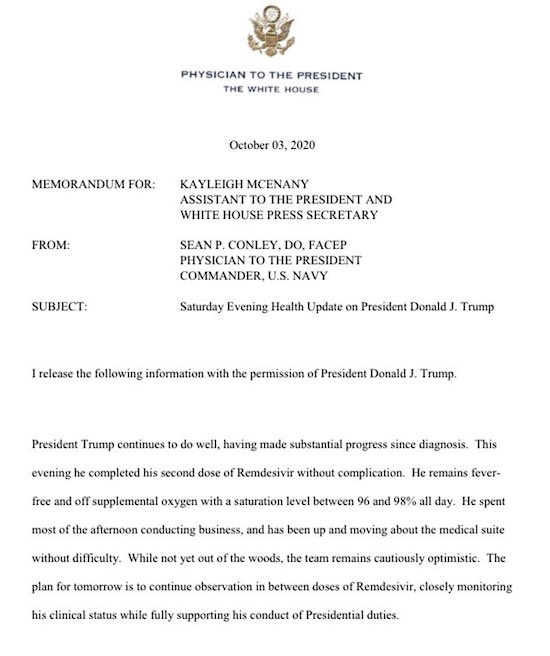

The damage cannot be undone.
• Inflation Targeting Is a Very Stupid Policy (Cookson)
Much ink has been spilled in recent weeks over the U.S. Federal Reserve’s announcement that it will now, in effect, target inflation over the whole cycle. The message from the rest of the developed world’s central banks is similar: Most say that if necessary they’ll do more to get inflation back on target. This week Christine Lagarde, president of the European Central bank, laid the groundwork for following the Fed. The ECB will now also allow inflation to overshoot on the upside. Presumably such comments are meant to reassure the handful of people still worried that central banks might move a little hastily once the effects of the pandemic have dissipated and growth and inflation start to pick up.
Economists, strategists and investors have parsed their comments, altered their forecasts and placed their chips accordingly. Yet any discussion of whether inflation targeting is a good thing has been notable by its absence, even before large swathes of the economy were shut down by government edict. This is strange, because to anyone who’s not a central banker it has become increasingly clear that inflation targeting is a policy of great stupidity. When they introduced inflation targeting, starting with the Reserve Bank of New Zealand in 1990, central banks doubtless worried about too much inflation, given their experience in the previous couple of decades. Since the turn of the century, however, they’ve largely been trying to counter disinflationary forces. Not very successfully, it must be said.
In trying to increase by a fairly random amount an index of prices that they largely can’t or shouldn’t control, central banks couldn’t have done much more harm. They’ve crushed the savings and finance industry by slashing interest rates to historically low levels and driven the prices of all financial assets to a point where the phrase “unprecedented” scarcely covers it. Interest rates, bonds, credit, equities, foreign exchange: Not a single market is unmanipulated by central banks. By encouraging sky-high asset prices and huge leverage, they’ve made it far more likely that the world ends up with the sort of debt deflation that helped make the 1930s depression so awful. Or, failing that, they may be setting us up for an inflationary burst that would hammer the price of pretty much every financial asset.
The problems start with what central bankers are trying to achieve. Presumably, if they’re to look at inflation at all, they should look only at inflation over which they have some control, to whit domestically generated inflation (broadly, non-traded inflation). However, overall inflation measures also include tradable inflation, which relates essentially to imported goods. For the biggest economies, roughly a third of overall inflation comes from tradable inflation. And whilst non-traded inflation has remained very stable over the years, the tradable slice has really only headed in one direction: down. Since the global financial crisis, U.S. traded goods prices have fallen about 10 percentage points.
Crucially, these prices are set by North Asia in general and China in particular. If domestic inflation is stable, then the change in the overall consumer-price index must be driven by the far more volatile tradable part. Both the overall direction and the cyclical moves in G7 inflation are thus set by China.

“The West’s self-perception is that it generally doesn’t do awful things… #WikiLeaks showed it’s not true” – Pilger
• Assange Forced Those Behind War Crimes To Look In The Mirror – Pilger (RT)
Assange exposed Western hypocrisy and discovered “too much truth,” so his trial became a form of “revenge,” journalist and filmmaker John Pilger told RT’s Going Underground. The main part of the extradition trial of Julian Assange came to a conclusion this week, and a decision is now expected to be announced in early January. Pilger, a long-time supporter of the WikiLeaks founder, closely monitored the proceedings, which were barely covered in the Western media despite the serious repercussions for journalism that a ruling to extradite Assange would entail. Assange’s demise came because he provided “too much truth” and exposed Western hypocrisy, Pilger believes. “He made those who committed those war crimes, he forced them to look in the mirror… That’s his unforgivable crime.”
The West’s self-perception is that it generally doesn’t do awful things, and that its politicians are mostly truthful and are held in check by an independent media. WikiLeaks showed all these things not to be true, Pilger said. As a result, Assange was blatantly mistreated by the British justice system, both during his September trial at London’s Old Bailey and before that. He received an unprecedentedly harsh sentence for skipping bail, was locked up in a maximum-security prison with terrorists and violent criminals, was prevented from communicating with his defense team in a reasonable way, and faced numerous other injustices. “There has not been due process in this court; there has been due revenge.”
Should Assange be extradited to the US and tried for things that are no different from what many other investigative journalists did for decades, it would set a dangerous precedent, Pilger warned. It would send a signal that the US can get to anyone in any country who dares to publish anything that is not to Washington’s liking.

“We were here for the ultimate of what the philosopher Guy Debord called The Society of the Spectacle: a man fighting for his life.”
• John Pilger, Eyewitness To The Agony Of Julian Assange (Arena)
The prevailing atmosphere has been shocking. I say that without hesitation; I have sat in many courts and seldom known such a corruption of due process; this is due revenge. Putting aside the ritual associated with ‘British justice’, at times it has been evocative of a Stalinist show trial. One difference is that in the show trials, the defendant stood in the court proper. In the Assange trial, the defendant was caged behind thick glass, and had to crawl on his knees to a slit in the glass, overseen by his guard, to make contact with his lawyers. His message, whispered barely audibly through face masks, was then passed by post-it the length of the court to where his barristers were arguing the case against his extradition to an American hellhole.
Consider this daily routine of Julian Assange, an Australian on trial for truth-telling journalism. He was woken at five o’clock in his cell at Belmarsh prison in the bleak southern sprawl of London. The first time I saw Julian in Belmarsh, having passed through half an hour of ‘security’ checks, including a dog’s snout in my rear, I found a painfully thin figure sitting alone wearing a yellow armband. He had lost more than 10 kilos in a matter of months; his arms had no muscle. His first words were: ‘I think I am losing my mind’.
I tried to assure him he wasn’t. His resilience and courage are formidable, but there is a limit. That was more than a year ago. In the past three weeks, in the pre-dawn, he was strip-searched, shackled, and prepared for transport to the Central Criminal Court, the Old Bailey, in a truck that his partner, Stella Moris, described as an upended coffin. It had one small window; he had to stand precariously to look out. The truck and its guards were operated by Serco, one of many politically connected companies that run much of Boris Johnson’s Britain.
The journey to the Old Bailey took at least an hour and a half. That’s a minimum of three hours being jolted through snail-like traffic every day. He was led into his narrow cage at the back of the court, then look up, blinking, trying to make out faces in the public gallery through the reflection of the glass. He saw the courtly figure of his dad, John Shipton, and me, and our fists went up. Through the glass, he reached out to touch fingers with Stella, who is a lawyer and seated in the body of the court.
We were here for the ultimate of what the philosopher Guy Debord called The Society of the Spectacle: a man fighting for his life. Yet his crime is to have performed an epic public service: revealing that which we have a right to know: the lies of our governments and the crimes they commit in our name. His creation of WikiLeaks and its failsafe protection of sources revolutionised journalism, restoring it to the vision of its idealists. Edmund Burke’s notion of free journalism as a fourth estate is now a fifth estate that shines a light on those who diminish the very meaning of democracy with their criminal secrecy. That’s why his punishment is so extreme.

Laws have never meant a thing in the chase for Assange.
• FBI Seized Legally Privileged Materials From Assange After Arrest (Gosztola)
The FBI in the United Kingdom enlisted the Ecuador government’s help in seizing legally privileged materials from WikiLeaks founder Julian Assange after he was arrested and expelled from their embassy in London on April 11, 2019. According to Gareth Peirce, one of Assange’s attorneys, that day she “made immediate contact with the embassy in regard to legally privileged material, an issue of huge concern.” Assange wanted the material—in addition to “confidential medical data”—”identified and released to his lawyers.” “Repeated requests by telephone, email and recorded delivery mail were entirely ignored by the embassy,” and in testimony submitted during the final day of evidence in Assange’s extradition trial, the embassy has never responded.
“One record of [Assange’s] entire archive” was effectively purloined, and without it, Peirce mentioned it has made putting together a defense in his extradition case more difficult because the initial allegations relate to communications, meetings, and events from 2010 and 2011. Proceedings in the evidentiary portion of Assange’s extradition trial concluded on October 1, and Judge Vanessa Baraitser announced she would rule on the request from the United States government on January 4, 2021. Before the last day wrapped, multiple statements from Peirce related to abuses of process in the case were entered into the record. They included details related to the espionage operation the Spanish security company UC Global carried out against Assange with the support of U.S. intelligence.
Peirce’s law firm Birnberg, Pierce & Partners asked the Australian Consulate in London for intervention because Assange is an Australian citizen. The Metropolitan Police in the United Kingdom claimed they played no role in the seizure or retention of any legally privileged materials. On May 20, 2019, the Australian Consulate received a request for Assange’s property to be “transferred to Ecuador.” The firm was invited to collect any “remaining possessions” that were not seized. When Assange’s property was collected shortly after, Peirce stated, “All legally privileged material was missing save for two volumes of Supreme Court documents and a number of pages of loose correspondence.”
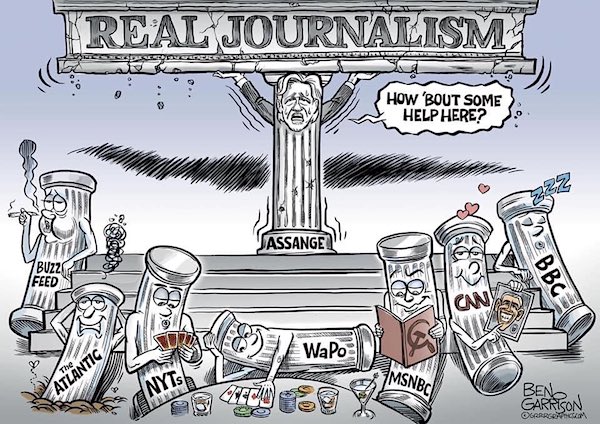

As if we never noticed.
• Low Status Science Increases Jargon Use (SD)
Jargon is commonly used to efficiently communicate and signal group membership. We propose that jargon use also serves a status compensation function. We first define jargon and distinguish it from slang and technical language. Nine studies, including experiments and archival data analyses, test whether low status increases jargon use. Analyses of 64,000 dissertations found that titles produced by authors from lower-status schools included more jargon than titles from higher-status school authors. Experimental manipulations established that low status causally increases jargon use, even in live conversations.
Statistical mediation and experimental-causal-chain analyses demonstrated that the low status i! jargon effect is driven by increased concern with audience evaluations over conversational clarity. Additional archival and experimental evidence found that acronyms and legalese serve a similar status-compensation function as other forms of jargon (e.g., complex language). These findings establish a new driver of jargon use and demonstrate that communication, like consumption, can be both compensatory and conspicuous.

Just so you know.
COVID-19 is as politically-charged as it is infectious. Early in the COVID-19 pandemic, the WHO, the CDC and NIH’s Dr. Anthony Fauci discouraged wearing masks as not useful for non-health care workers. Now they recommend wearing cloth face coverings in public settings where other social distancing measures are hard to do (e.g., grocery stores and pharmacies). The recommendation was published without a single scientific paper or other information provided to support that cloth masks actually provide any respiratory protection. Let’s look at the data.
The theory behind mask wearing:
- Source control: Cloth mask can trap droplets that come out of a person’s mouth when they cough or sneeze.
- Protection: Personal Protective Equipment (PPE) – only N95 masks
Transmission of SARS-CoV-2
Note: A COVID-19 (SARS-CoV-2) particle is 0.125 micrometers/microns (μm); influenza virus size is 0.08 – 0.12 μm; a human hair is about 150 μm.
*1 nm = 0.001 micron; 1000 nm = 1 micron; Micrometer (μm) is the preferred name for micron
*1 meter is = 1,000,000,000 [trillion] nm or 1,000,000 [million] microns
Droplets
- Virus is transmitted through respiratory droplets produced when an infected person coughs, sneezes, or talks.
- Larger respiratory droplets (>5 μm) remain in the air for only a short time and travel only short distances, generally <1 meter. They fall to the ground quickly.https://www.thelancet.com/journals/lanres/article/PIIS2213-2600(20)30245-9/fulltext
- This idea guides the CDC’s advice to maintain at least a 6-foot distance.
- Small (<5 μm) aerosolized droplets can remain in the air for at least 3 hours and travel long distances (up to 27 ft.).
Air currents
- In an air conditioned environment these large droplets may travel farther.
- Ventilation. Even the opening of an entrance door and a small window can dilute the number of small droplets to one half after 30 seconds. (This study looked at droplets from uninfected persons). This is clinically relevant because poorly ventilated and populated spaces, like public transport and nursing homes, have high SARS-CoV-2 disease transmission despite physical distancing.
Humidity
- Since 1961, experiments showed that viral-pathogen-carrying droplets were inactivated within shorter and shorter times as ambient humidity was increased. Dryness drives the small aerosol particles. See e.g., review of studies, https://aaqr.org/articles/aaqr-20-06-covid-0302
Conclusions
The preponderance of scientific evidence supports that aerosols play a critical role in the transmission of SARS-CoV-2. Years of dose response studies indicate that if anything gets through, you will become infected.
- Thus, any respiratory protection respirator or mask must provide a high level of filtration and fit to be highly effective in preventing the transmission of SARS-CoV-2. (Works for Mycobacterium tuberculosis (3μm)
- Public health authorities define a significant exposure to COVID-19 as face-to-face contact within 6 feet with a patient with symptomatic COVID-19 that is sustained for at least a few minutes (and some say more than 10 minutes or even 30 minutes).
- The chance of catching COVID-19 from a passing interaction in a public space is therefore minimal.
We try to run the Automatic Earth on donations. Since ad revenue has collapsed, you are now not just a reader, but an integral part of the process that builds this site.
Click at the top of the sidebars for Paypal and Patreon donations. Thank you for your support.

A society is as advanced as its treatment of its weak, its handicapped and incapacitated.”
– Nassim Taleb



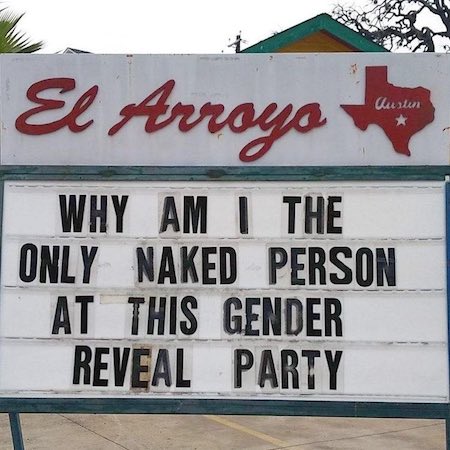

Support the Automatic Earth in virustime, election time, all the time.



